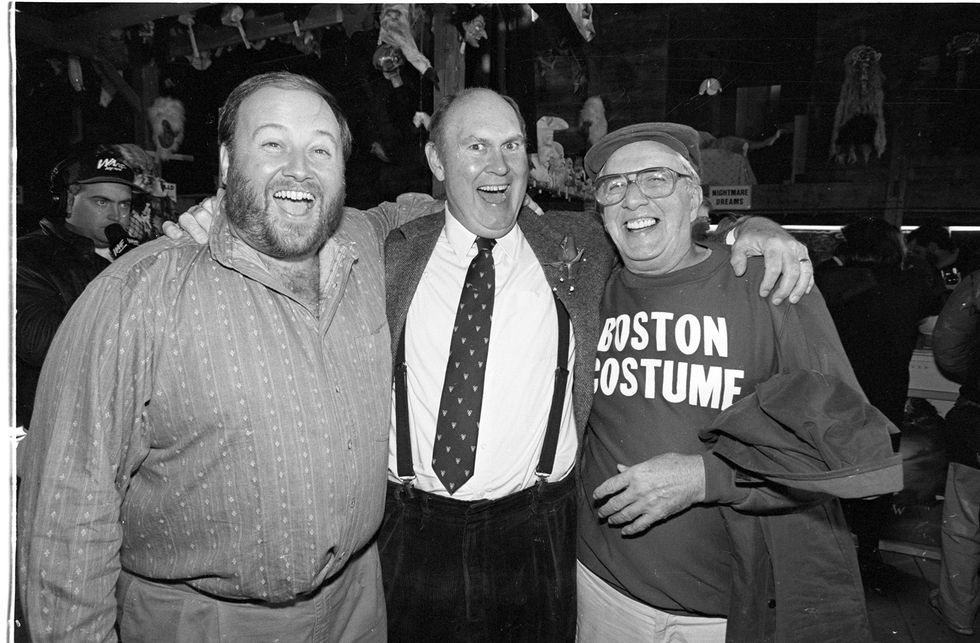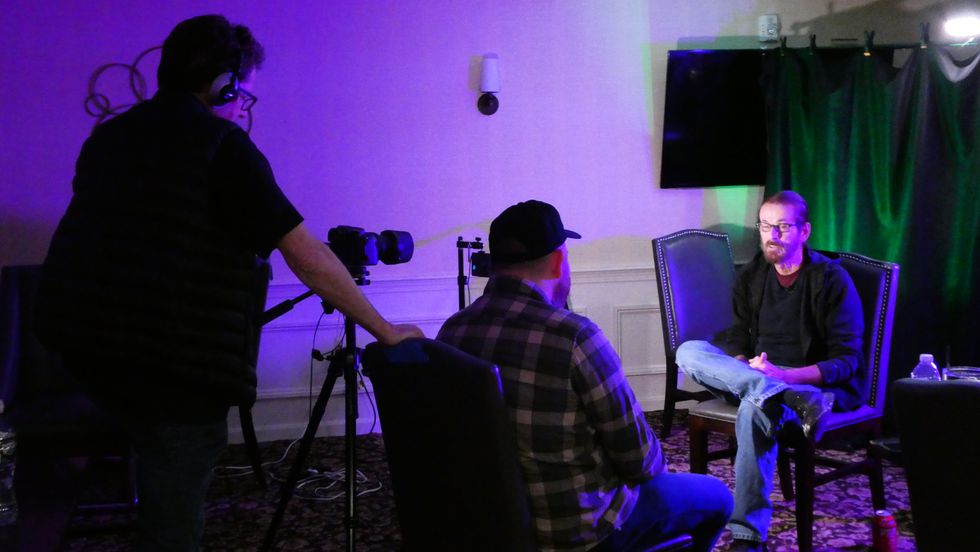
Not to scare anyone here, but documentary filmmaking can be very scary and harrowing work. Projects can take years to complete and often require hundreds of interviews and sifting through thousands of hours of newsreels and footage.
But, at the end of the day, they can also tell very cool—and often very meaningful—stories about important people and events which audiences might not have even known about before.
Such is the case with the recent documentary Spooktacular!, which made its world premiere at Alamo Drafthouse’s Fantastic Fest in Austin, Texas. Unraveling the story of Spookyworld, America’s first horror theme park, and its enigmatic, Vincent Price-esque creator David Bertolino, Quinn Monahan’s feature documentary is a great testament to the genre’s ability to both educate and entertain.
We sat with Monahan and the Spooktacular! team to chat about the film and explore their tips for any aspiring documentary filmmakers looking to tackle large, multi-year projects—plus said projects’ ability to connect with audiences and tell meaningful, if not at times horrifying, stories.
Editor’s note: This interview has been edited for length and clarity.
No Film School: Tell us a bit about how this Spooktacular! documentary, and the story of Spookyworld, came together?
Quinn Monahan: It came together because David [Bertolino] and I were friends and neighbors and he started to tell me all these stories about Spookyworld. I didn’t know anything about the spooking industry. I didn’t know anything about the horror industry whatsoever.
Honestly, I think I had some vague awareness that there were other haunted theme parks around the country, but when he started telling me about it, and then I was looking it up on YouTube and I realized, oh, this is a big deal. This guy started this industry.
And so then I was looking at the old commercials and whatnot and thought that this would make this very visual, great documentary. And I was already a filmmaker, so I tried to push David into it and he was very busy producing a play and this and that, but eventually he came around to realize that, yeah, it was kind of an important thing. And so we got started making it right at the beginning of COVID-19 and all that.
 ‘Spooktacular!’Courtesy of Fantastic Fest
‘Spooktacular!’Courtesy of Fantastic Fest
NFS: Can you tell us a bit more about your ideation process for this documentary? How did you land on its visual style and language?
David Bertolino: Well, we didn’t even know what direction it was going to go until we started it. We had no idea what footage was out there to capture. And as Quinn has said at the Q&A, we just didn’t want a bunch of talking heads. So we tried to reach out to the community in the Boston market initially and asked for a contribution of any footage that existed.
Monahan: We weren’t too concerned though because we knew David had been in touch with everybody over the years, and he had a lot of people that he wanted to talk to. But as a filmmaker, my biggest concern was: how are we going to illustrate this? But then slowly, even though we put calls out for footage, just nothing was coming in.
David had a few things that he didn’t even realize he had. He said, I’ve got a box of tapes. And as I started going through, I was like, oh, this is good. This is a good start. But what kind of came through were two people who were shooting sort of contemporaneous documentary footage there. That was Bruce Miller and Ed Gant. Ed Gant being a designer there, and Bruce Miller playing Leatherface for years and years at the park.
So between those guys and some other things, and of course some terrific journalist’s journalism and still photos, we were able to not have too many talking heads and just be able to tell our story visually, which is what to me was the most important.
 (L to R) David Bertolino, Willard Scott and Sam BertolinoCourtesy of Fantastic Fest
(L to R) David Bertolino, Willard Scott and Sam BertolinoCourtesy of Fantastic Fest
NFS: You all mentioned a couple of interesting things in the Q&A at the premiere, most notably that this film was shot partly during COVID-19 (hence the Zoom interviews) and that you were producing a podcast in tandem with the film as a way to provide additional interviews and materials. What were the unique advantages, and perhaps issues, with each approach?
Anthony Landry: I think that when it came to creativity in 2020, everybody’s hand was forced. David was invested in the film. We had people lined up to be interviewed. We had stars lined up to be interviewed. Lloyd Kaufman was in the wings. We had Victoria Price ready to facilitate a deal to use footage of Vincent Price in the film.
Monahan: Not to mention Tom Savini, who was a huge help. We were supposed to go and interview him in person. But by the time COVID-19 rolled around, we realized half the interviews were going to be Zoom because we just couldn’t travel. Nobody wanted to show up anywhere. So the Zoom stuff became very organic to COVID-19.
Landry: Yeah. So what we ended up saying was, let’s serve two beasts. Because I was mentioning to them like, look, we know that we have an evergreen property here. And let’s really lock into this generational ideal of Spookyworld.
So let’s blow the dust off the memories, create the podcast to get the buzz going, and then lead us right up to the release of the film. So what we did was we specifically crafted questions for the film to utilize on Zoom (which we then crafted into these vintage TV shots as a way to present them in the film) and also to use these interviews for a podcast.
We have about a half dozen interviews still waiting that I want to release when this thing is ready to be mass consumed. But I think that the great part of the podcast aspect in general was that we were able to do long form interviews with these folks and then during the process we’d be like, oh, wait a minute. That’s a great writing point. Let’s add an additional question at the end to serve the beast of the film.
 ‘Spooktacular!’Courtesy of Fantastic Fest
‘Spooktacular!’Courtesy of Fantastic Fest
Jorden: That’s right, and we didn’t actually have a lot of the questions written out early in the process. And so we had big holes in much of the story and we continually had to go back to David and say, well, how did this happen? For example, you said you got so many people there opening night. How did you do that? Did you have commercials?
Monahan: Yeah, we interviewed David several times. Several times because as the story developed we had to go back for more context and interviews.
Jorden: And as we began to develop it, we created the narrative and with each new interview that came in, it would give it a different feeling, a different flavor. So we became detectives when we built this story, and as we would make new discoveries, we would plug it in where we could.
 ‘Spooktacular!’Courtesy of Fantastic Fest
‘Spooktacular!’Courtesy of Fantastic Fest
NFS: If you could provide any sort of advice to any other documentary filmmakers looking to start on their own projects of their own, what advice would you share with them?
Monahan: A couple of things that I would say add to help other filmmakers, is that when you have a story and you don’t have a whole lot of visuals—which we knew going into our film—is to take a good, hard look at public domain footage.
There are hundreds and hundreds of movies in the public domain, which you can use for any purpose and find your visuals. The audience will get it even if you’re cutting something out of a cartoon, as long as the story is about something similar to what’s going on. Don’t be afraid to think outside the box because the audiences are quick. They make those connections very quickly.
 ‘Spooktacular!’Courtesy of Fantastic Fest
‘Spooktacular!’Courtesy of Fantastic Fest
Monahan: For example, in our search for public domain footage, Vincent Price started coming up. Obviously I was looking at horror films and public domain horror stuff. Vincent Price has four or five public domain films. And I started grabbing clips that I was sharing with David, saying maybe he could be a stand-in for you and your role in the story.
And he was like, yeah, I was a Vincent Price fan. And so we said, well, that clinches it then. This is the connection. And so we did reach beyond the public domain into the fair use arena, and we were able to use long clips from House of Wax, which is not in the public domain. It is fair use. And we did get approved for fair use because we’re talking directly about that subject matter.
And so I would say to your filmmakers who, especially if they’re on a low budget, go to YouTube, find that public domain footage and start playing around with it because that gets the imagination going and can help you realize how you could do this or pull off this in and overall figure out how tell this story in a meaningful way.
Author: Jourdan Aldredge
This article comes from No Film School and can be read on the original site.
